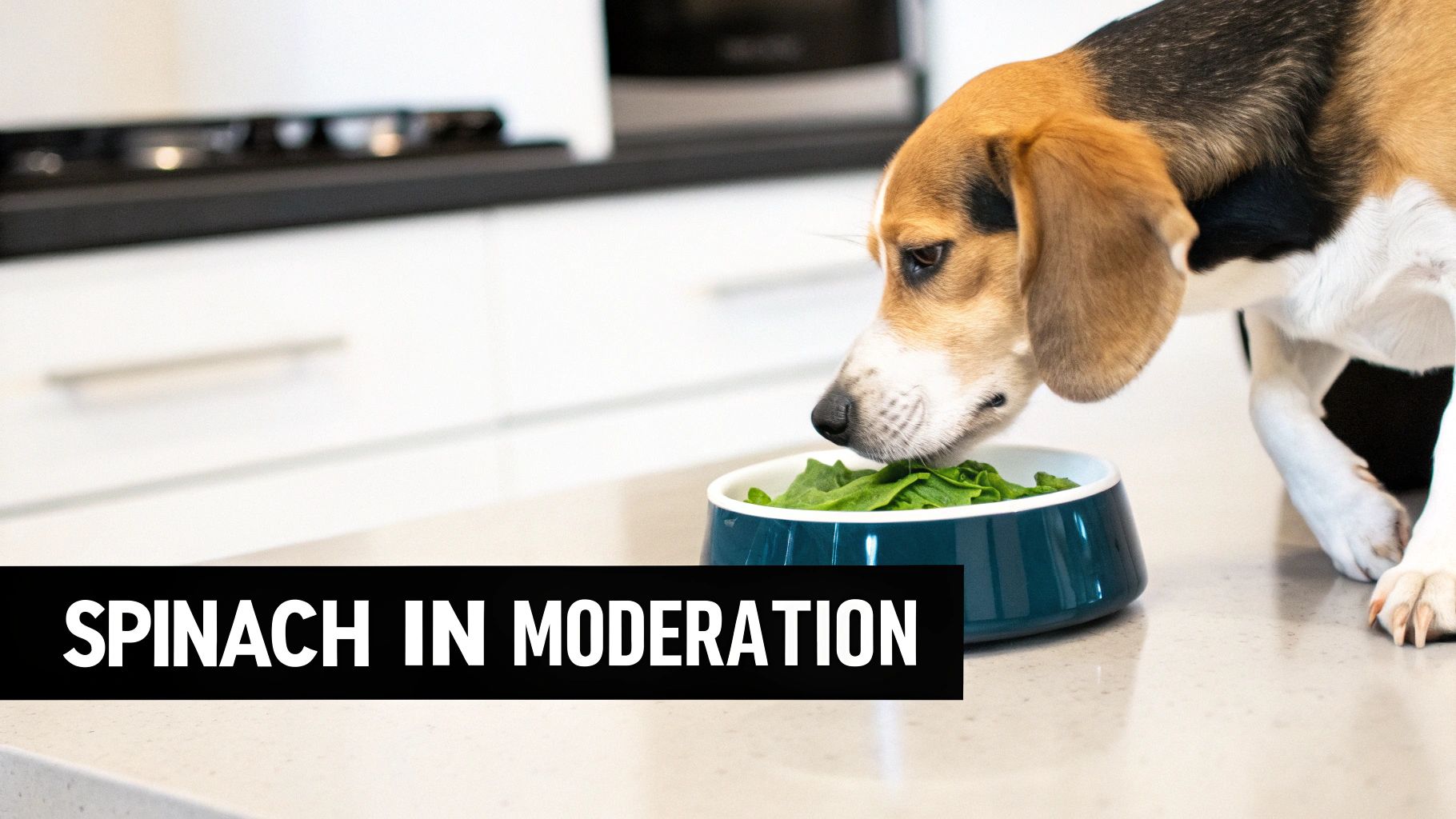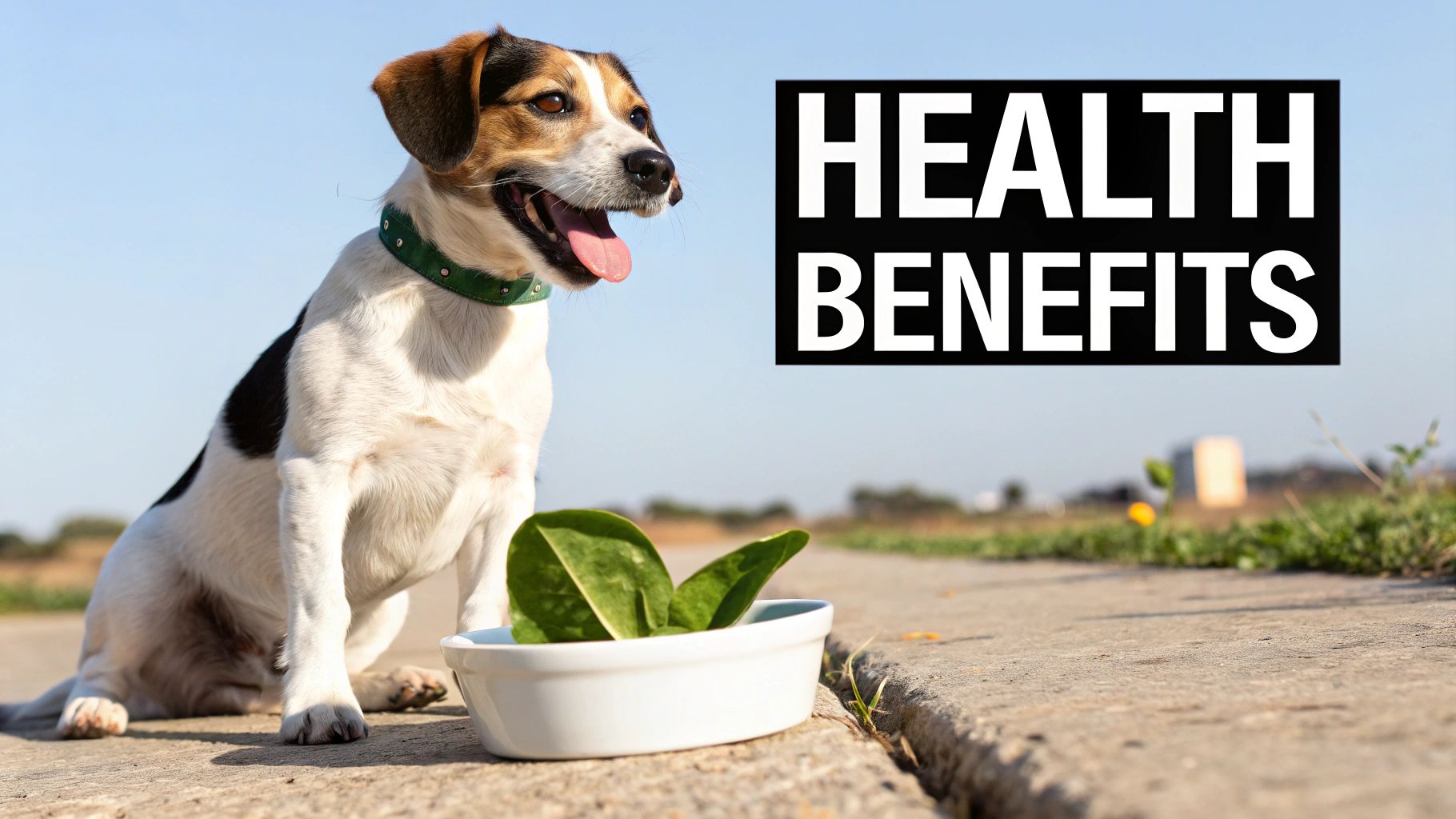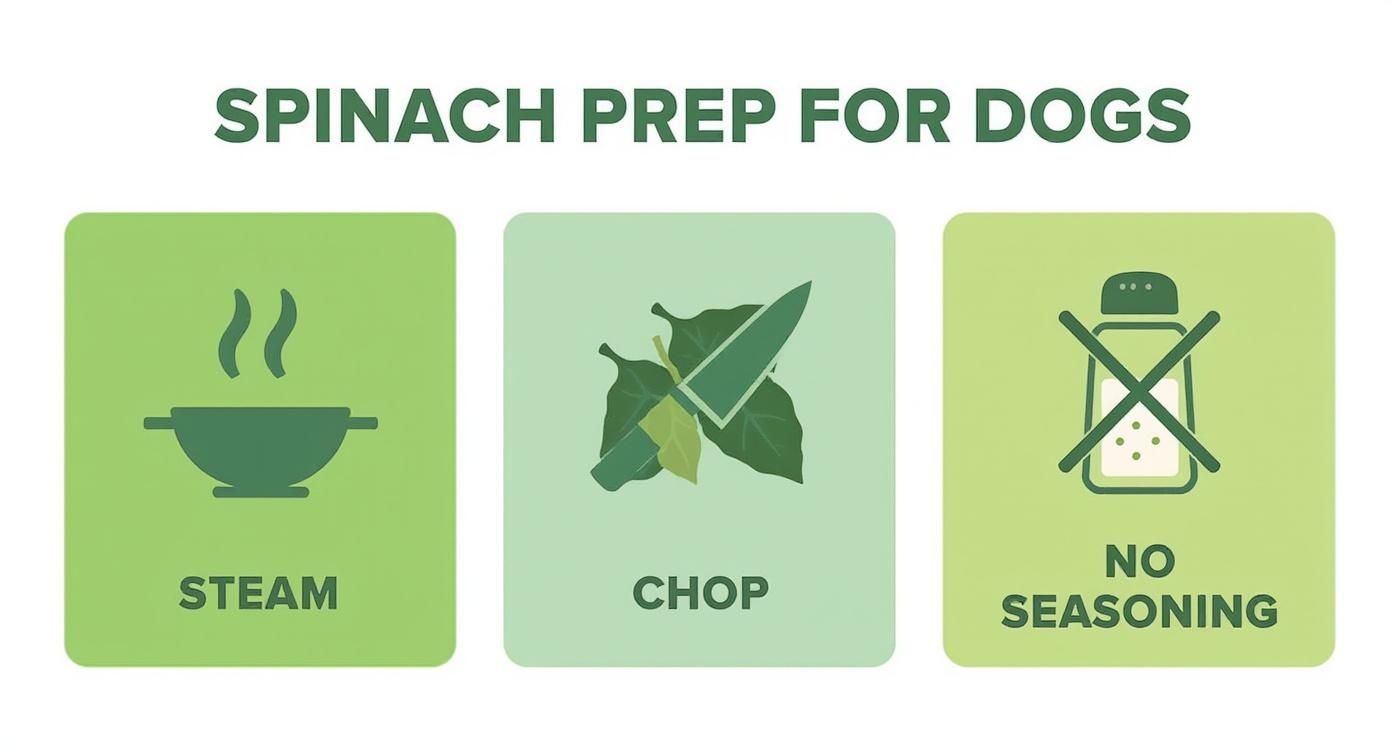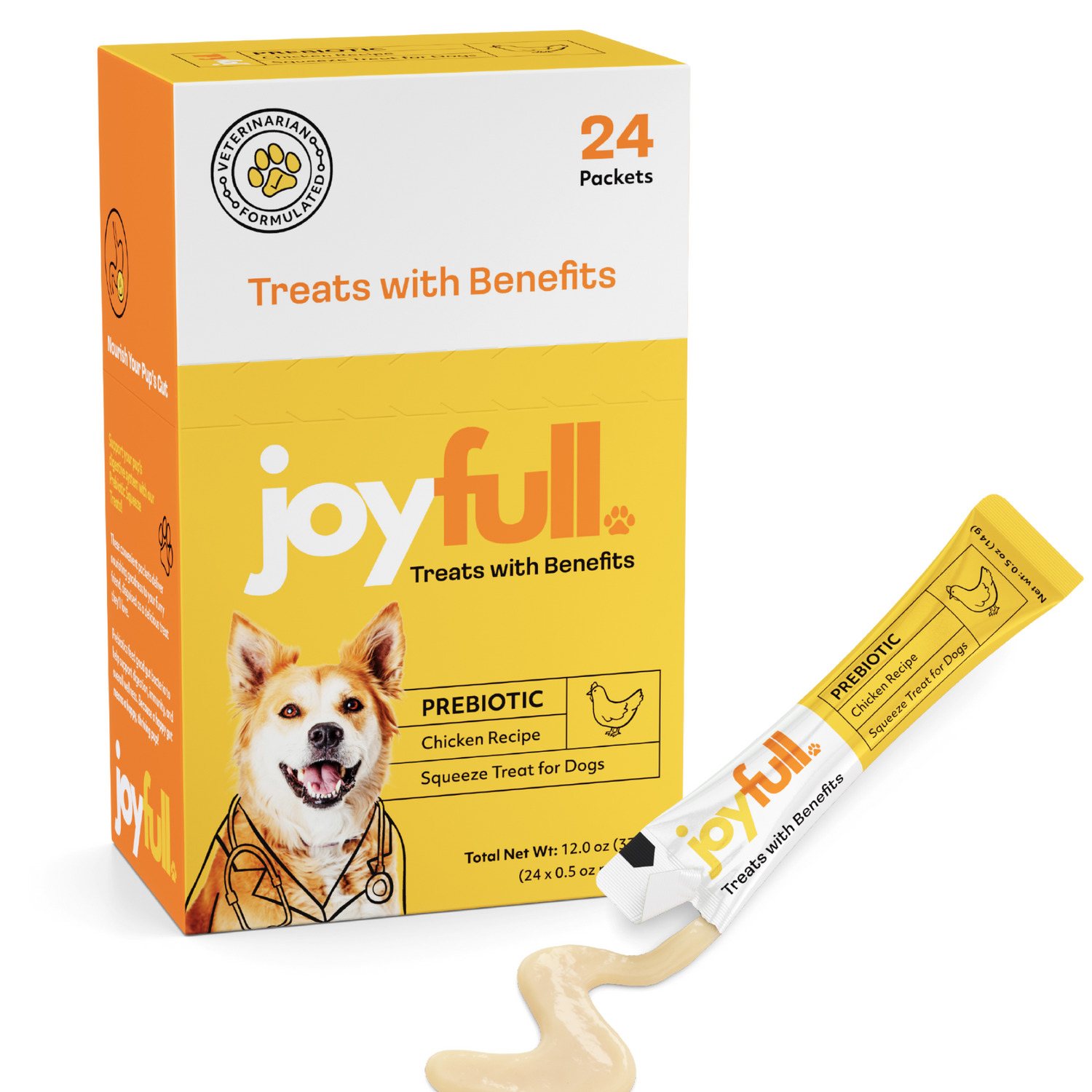
Is Spinach Good for Dogs? A Complete Guide
So, you're eyeing that bag of spinach in the fridge and wondering if you can share some with your furry best friend. The short answer is yes, dogs can eat spinach, but it comes with a couple of important "buts." Think of it as a healthy, occasional treat, not a daily staple.
The Short Answer on Sharing Spinach with Your Dog

Tossing some spinach into your dog's bowl is a great way to add a powerful nutritional punch. When you do it right, this isn't just a leafy green; it's a natural supplement that can give your dog's health a real boost.
The main thing to keep in mind is the oxalate content. Oxalates are natural compounds found in spinach that can mess with mineral absorption and, in very large quantities over time, could potentially cause issues for dogs with kidney problems. This is why "moderation" is the golden rule here—it's not just a friendly suggestion.
For most healthy dogs, a little bit of cooked spinach is a fantastic addition to their diet. It's loaded with vitamins A, C, and K, plus essential minerals like iron and calcium that support a strong immune system and healthy bones. And at only 7 calories per cup, it’s a guilt-free way to sneak in some extra goodness. You can find more details about the various benefits of spinach for dogs' health in this helpful guide.
Here's a quick look at the key takeaways before you start cooking.
Spinach for Dogs At a Glance
| Aspect | Details |
|---|---|
| Is it Safe? | Yes, in small, infrequent amounts for healthy dogs. |
| Key Concern | High oxalate content can interfere with mineral absorption and potentially affect kidneys. |
| Best Preparation | Lightly steamed or boiled, with no salt, seasonings, or oils. |
| Avoid | Raw spinach (hard to digest) and creamed spinach (too rich and fatty). |
| Who Should Avoid It? | Dogs with a history of kidney disease or bladder stones. |
Ultimately, whether spinach is a good choice for your dog comes down to a few simple guidelines.
So, when you ask, "is spinach good for dogs?" the answer depends on a few key factors:
- Preparation: Always cook it. Steaming is the best way to preserve nutrients while making it easy to digest.
- Portion Size: A little goes a long way. Keep servings small and don't make it a daily habit.
- Your Dog's Health: If your dog has a history of kidney problems, it's best to skip the spinach altogether.
The Good Stuff: What Spinach Brings to Your Dog's Bowl

When you ask if spinach is good for dogs, you’re really asking what this leafy green can do for their health. The answer is quite a lot. Think of it less as just a low-calorie filler and more like a natural multivitamin that supports your dog's daily well-being.
For starters, spinach is loaded with Vitamin K, a powerhouse nutrient that's absolutely vital for healthy blood clotting. This might not seem like a big deal day-to-day, but if your dog gets a little scrape at the park, Vitamin K is what helps their body stop the bleeding effectively.
Then there's the iron. Iron is essential for making red blood cells, which act like tiny oxygen delivery trucks for your dog's body. They carry fuel to every muscle, powering everything from an epic game of fetch to a simple walk around the block.
A Deeper Dive into Cellular Health
Spinach also packs a serious antioxidant punch with compounds like beta-carotene and lutein. These are like your dog's personal cellular bodyguards, fighting off nasty free radicals that can cause damage and speed up the aging process. For an older dog, this can translate to better mobility and more zest in their golden years.
The benefits don't stop there. The fiber in spinach is fantastic for keeping their digestive system running smoothly, promoting regular bowel movements and a healthy gut—the foundation of overall wellness. There's a growing body of research showing just how much dogs can benefit from plant-based foods, which contain unique phytonutrients that support everything from gut health to brain function. Learning how nutrition contributes to your dog's longevity really highlights the impact of a balanced diet.
A 2021 review in the Journal of Animal Physiology and Animal Nutrition found that dog diets including vegetables like spinach can significantly reduce signs of intestinal inflammation. It’s a great example of how the right plant-based ingredients can actively improve a dog's health from the inside out.
Just as spinach offers some anti-inflammatory perks, other natural foods can play a similar role. For instance, you might be curious about the benefits of turmeric for dogs, which is another great way to support their joint health and overall comfort.
The Deal with Oxalates: Should You Be Worried?

So, with all those vitamins and minerals, what's the catch? The main reason some folks hesitate to give their dogs spinach comes down to one word: oxalates.
This is the heart of the debate. Spinach contains a naturally occurring compound called oxalic acid. In the body, this acid can bind with minerals, most notably calcium. For a deep dive into the science, you can find great nutritional guidance on the AKC website.
For a healthy dog, this process is no big deal. Their kidneys are well-equipped to filter out these bound particles, and everything passes through their system just fine. It's a normal part of digestion.
The real concern pops up in two very specific situations: when a dog is fed huge quantities of spinach over a long time, or if the dog already has compromised kidney function. In those cases, the system can get overloaded.
Why Too Much Can Be a Problem
When your dog’s body can't process the oxalates fast enough, they can crystallize. Think of it like rock candy forming in a sugar solution. These tiny, sharp crystals can cause irritation in the urinary tract and, in more serious cases, contribute to the formation of painful calcium oxalate bladder stones.
This is exactly why your dog's individual health history is the most important factor here.
For the average healthy dog, the amount of spinach required to cause a problem is massive. The risk is incredibly low when spinach is treated as what it should be: an occasional, healthy mix-in, not a staple of their diet.
Here’s a simple way to think about it. For most of us, a slice of chocolate cake is a harmless, enjoyable treat. But eating a whole cake every day? That's going to cause problems. It’s the same principle with spinach for your dog. A spoonful here and there is the single slice of cake—not the whole thing.
How to Safely Prepare Spinach for Your Dog
So, you're ready to add some green goodness to your dog's bowl? Prepping spinach the right way is simple, but it's key to making sure your pup gets all the benefits without any of the downsides. Our main goal here is to make the nutrients easy for their system to absorb while bringing down those oxalate levels.
Giving your dog raw spinach isn't the best idea. It’s pretty tough on their digestive system and has the highest concentration of oxalates. A little bit of light cooking is all it takes to unlock its nutritional power.
Cooking Methods and Preparation Steps
The best ways to cook spinach for your dog are steaming or blanching. These gentle methods do a great job of breaking down the plant's tough cellular walls. This not only makes the spinach easier to digest but also helps reduce some of that oxalic acid.
And just like with our own food, what you cook with matters. Using the best cookware for health and safe cooking is a smart move to ensure nothing unwanted leaches into their meal.
Ready to get started? Just follow these simple steps:
- Wash It Well: First things first, give those fresh spinach leaves a good rinse under cool running water. This gets rid of any dirt or leftover pesticides.
- Steam or Blanch: Pop the clean leaves into a steamer for just a couple of minutes—you're looking for them to be wilted but still a vibrant green. Another great option is to blanch them: drop the leaves into boiling water for about 30 seconds, then scoop them out and plunge them into a bowl of ice water to stop the cooking process.
- Chop It Up: After the spinach has cooled down, chop it into tiny, bite-sized pieces. You could even toss it in a blender and puree it. This is a super important step to make sure it doesn’t become a choking hazard.
- Serve It Plain: The easiest way to serve it is to just mix the prepared spinach right into your dog’s usual food. This way, they get a little bit of everything in each bite.
Crucial Reminder: Keep it plain! Never add any salt, butter, oil, garlic, onions, or any other seasonings. Ingredients we love can be seriously harmful, or even toxic, to our dogs.
What to Absolutely Avoid
Keeping your dog safe is priority number one. Avoiding a few common mistakes is just as important as knowing the right way to prepare the spinach.
- No Seasonings: This is a big one. Kitchen staples like garlic and onions are toxic to dogs. They can cause serious health problems, including major damage to their red blood cells.
- Avoid Creamed Spinach: That rich, creamy side dish we love is a definite no-go for dogs. It’s loaded with fat and dairy, which can trigger painful pancreatitis or at least a very upset stomach.
- Skip Canned Spinach: Canned versions of vegetables are almost always packed with salt. The sodium levels are way too high for dogs and can lead to dehydration or even sodium ion poisoning. Fresh or frozen is always the better choice.
Getting the Serving Size Right
When it comes to adding new foods to your dog's diet, "moderation" is the golden rule, and spinach is no exception. But what does that really mean in practice? A great guideline is the 10% rule: any treats or extras, including healthy greens, should make up no more than 10% of your dog's total daily calories.
Think of spinach as a nutritional boost or a healthy "topping," never as a full meal replacement. It’s packed with fiber, which is great in small amounts but can lead to an upset stomach if you overdo it. The best approach? Start with a tiny portion and see how your dog's tummy handles it before making it a regular, occasional treat.
This infographic breaks down the best way to prepare spinach to make it safe and easy for your dog to digest.

The bottom line is simple: properly prepared spinach is the only way to go. Always make sure it's cooked (steamed is ideal), finely chopped, and completely free of any seasonings.
Portions Based on Your Dog's Size
To help you get the amounts just right, I've put together a quick guide based on dog weight. These are suggestions for how much cooked, chopped spinach to offer as an occasional treat.
Here's a helpful table to take the guesswork out of serving sizes:
| Dog Size | Weight Range | Suggested Serving (per day) |
|---|---|---|
| Toy/Small | Under 20 lbs | 1 teaspoon |
| Medium | 20-50 lbs | 1-2 tablespoons |
| Large | Over 50 lbs | Up to 1/4 cup |
Sticking to these serving sizes allows you to share the nutritional goodness of spinach without risking any issues from too much fiber or oxalates.
Figuring out your dog's overall food intake can sometimes feel like a puzzle. If you want to dial in their meals perfectly, using a specialized tool can be a huge help. You can get a better handle on their needs with this handy dog food portion calculator. And, as always, if you have any questions about your dog's specific health needs, a quick chat with your vet is the best course of action.
When to Keep Spinach Off the Menu
While spinach can be a healthy treat for many dogs, it's a hard "no" for some. If your dog has certain health issues, the risks of this leafy green just aren't worth the potential benefits. Knowing when to skip it is key to keeping your furry friend safe.
The biggest red flag with spinach comes down to one word: oxalates. In a healthy dog, the kidneys have no problem filtering out these naturally occurring compounds. But for a dog with kidney disease or a history of urinary problems, it's a different story.
The Problem with Kidney and Bladder Stones
When compromised kidneys can't process oxalates efficiently, the compounds can build up. This overload can lead to the formation of sharp little calcium oxalate crystals, which can clump together to form painful bladder or kidney stones.
If your vet has ever diagnosed your dog with these types of stones, spinach should be off the table for good. It's just not worth risking a recurrence. The same goes for any pup with pre-existing kidney conditions or renal stress.
Your veterinarian's guidance is paramount. Before adding any new food to the diet of a dog with a known health condition, a professional consultation is essential to make a safe, informed decision.
It's also worth noting that spinach is packed with fiber. While fiber is usually a good thing, a sudden increase can sometimes lead to an upset stomach or gas. You can learn more about what causes this in our article about why dogs get gassy.
Got More Questions About Spinach for Your Dog?
Even after weighing the pros and cons, you might still have a few lingering questions. Let's tackle some of the most common ones I hear from pet owners.
Can Puppies Have a Little Spinach?
Technically, yes, but you need to be extra careful. A tiny amount of cooked, finely chopped spinach is generally okay, but a puppy's system is incredibly delicate. Their growing bones need to absorb minerals like calcium without interference.
Because of the high oxalate content, it's best to keep any spinach servings minuscule and very rare. Honestly, it's always smartest to run it by your vet before adding anything new to your puppy's specialized diet.
Is Frozen Spinach Just as Good as Fresh?
Absolutely! Frozen spinach can be a fantastic and convenient choice. Just make sure you're buying the plain, unseasoned kind—nothing with added salt, sauces, or other ingredients.
The flash-freezing process is great because it locks in most of the vitamins and minerals. The key is to thaw and cook it completely, then squeeze out any excess water before dicing it up for your dog's bowl.
The Golden Rule: Whether you go with fresh or frozen, the number one rule is to always serve spinach cooked and completely plain. That means no salt, no butter, and definitely no garlic or onions, which are toxic to dogs.
How Do I Know if My Dog Is Having a Bad Reaction?
It's not common, but some dogs just don't jive with spinach. If you've just added it to their diet, keep an eye out for any signs of an upset stomach.
You might notice things like:
- Vomiting or diarrhea
- Unusual gassiness or a bloated belly
- A sudden lack of interest in their food
Most of the time, these signs just mean the serving was a bit too big for them to handle. If you see any of these issues, hold off on the spinach and give your vet a call if the symptoms don't clear up.
At Joyfull, we believe in making pet wellness simple and transparent. Our scientifically reviewed, clean-ingredient formulas ensure your pet gets the very best, because a healthful life isn’t just for humans. Discover better-for-you pet wellness today.

